Table of Contents
Important Questions for Class 12 History Chapter 14 Understanding Partition (Politics, Memories, Experiences)
Important Questions for Class 12 History Chapter 14 – 2 Marks Questions
Question 1.
“The relationship between India and Pakistan has been profoundly shaped by the legacy of partition.” Explain any two consequences of it. (All India 2017)
Answer:
It is true that the relationship between India and Pakistan has been profoundly shaped by the legacy of partition.
The two consequences of this are:
- Indian haters in Pakistan and Pakistan haters in India are both products of partition. Some people spread false ideas in India that Muslims are cruel, bigoted, unclean and descendants of invaders, while Hindus are kind, liberal and pure. They even wrongly believed that Indian Muslims are supporters of Pakistan.
- Similarly in Pakistan, feeling was spread that Muslims are fair, brave, monotheists and meat-eaters, while Hindus are dark, cowardly, polytheist and vegetarians.
Question 2.
Why did the Congress not accept the proposal to form a joint government with the Muslim League in the United Provinces? Give any two reasons. (HOTS; Delhi 2012)
Answer:
The two reasons were as follows:
- The Congress had won an absolute majority in the province.
- The Muslim League supported landlordism whereas the Congress wanted to abolish it.
Question 3.
Was the demand of the league reasonble? Comment. (Delhi 2011)
Answer:
No, the demand of league was not reasonable.
It clearly demanded the partition of India on the basis of religion.
Important Questions for Class 12 History Chapter 12 – 4 Marks Questions
Question 4.
Examine the events that took place during 1920s and 1930s which consolidated the communal identities in the country.
(All India 2017)
Answer:
Between 1920 and 1930, many incidents took place which created tensions. Frequent riots took place. Many Hindu organisations were formed. They carried out purification movement and started playing communal cards. Hindu identity was defined against Muslim identity by the Hindu Mahasabha. Music playing before the mosque became frequent.
Hindi became the language of the Hindus and Urdu became the language of Muslims. There were increased communal feelings within Hindus and the Muslims. Hindus were angered by the rapid spread of ‘tabligh’ (propaganda) and ‘tanzim’ (organisation) after 1923. Gaps between Hindus and Muslims widened due to these deliberate actions.
In the 1937 elections, the communal parties, the Hindu Mahasabha and the Muslim League fared poorly. Apprehensive of their survival, both the parties began to make use of religion to secure the support of the masses. The British encouraged the Muslim League and when the Congress resigned in 1939, they were invited to form the government in the provinces.
Question 5.
Analyse the provisions of Cabinet Mission of 1946. (HOTS; Delhi 2015)
or
Examine the recommendations of the Cabinet Mission and explain the reasons for rejecting the plan suggested by Cabinet Mission in 1946 by both Congress and the Muslim League.
Answer:
Recommendations of the Cabinet Mission were as follows:
- A loose three-tier confederation of United India.
- A weak Central Government controlling foreign affairs, defence and communications.
- Provincial assemblies were grouped into three sections, i.e. section A Hindu majority provinces, section B and section C Muslim-Majority provinces of the North-West and the North-East India.
- The provinces would have their own executives and legislatures.
Reasons of rejecting the plans were as follows:- The league wanted the right to secede from the Union to sections B and C.
- The Congress wanted that the provinces should have the right to join any group.
Therefore, neither the league nor the Congress agreed to the proposal.
Question 6.
Analyse the impact of partition of India on Punjab and Bengal. (HOTS; All India 2015)
Am. Impact of partition was horrendous in the Punjab.
- There was carnage on both sides across the border. Near total displacement of Hindus and Sikhs took place from West Punjab to Eastward into India and similarly Punjabi Muslims were displaced from Indian Punjab to Westward into Pakistan.
- There was massacre in Amritsar, thousands of people were killed in Punjab, hundreds of women were raped and abducted. Properties were looted and immovable property were captured.
- Many women killed themselves in order to protect themselves from being dishonoured by violent mob. This total displacement of Hindu, Sikh and Punjabi-speaking Muslims happened in a relatively short period between 1946 and 1948.
In Bengal situation was more or less similar but process of migration was more protracted.
- There was no total displacement of population in Bengal as many Hindus remained in East Bengal and many Muslims in West Bengal. But in Bengal people were also murdered in large numbers, women were raped and abducted.
- Finally Bengali Muslims of East Pakistan broke away from Pakistan and created independent country Bangladesh in 1971-72.
Question 7.
Why did the Congress reject the offer of the Muslim League to form a joint government? Explain. (All India 2009)
Answer:
There were various reasons due to which the Congress rejected the offer of the Muslim League to form a joint government which were:
Absolute Majority of Congress:
In the United Provinces, the Muslim League ‘ wanted to form a joint government with the Congress. The Congress had won an absolute majority in the province so it rejected the offer.
Ill effects of the Rejection:
It is argued that this rejection convinced the league that if India remained united, then Muslim would find it difficult to gain political power because they would remain a minority.
Muslim League to be the Sole Spokesman of Muslims:
The league assumed that only a Muslim party could represent Muslim interests and the Congress was essentially a Hindu party. Jinnah’s insistence that the League be recongised as the sole spokesman of Muslims could convince few at the time.
Muslim League’s Support to Landlordism:
Congress Party rejected the Muslim League proposal for a coalition government because the League tended to support landlordism, which the Congress wished to abolish.
Question 8.
Examine the views of Gandhiji against the partition of India. (Delhi 2008)
Answer:
Gandhiji W’as against the partition of India. He worked for Hindu-Muslim unity. He rejected religion as the basis of forming a “ nation. He belived in Hindu-Muslim unity- based on sharing of a common culture and a single nation. Gandhiji believed that the Pakistan demand had put forward by the Muslim League was un-Islamic.
He called it as sinful. According to him Islam stood for the unity and brotherhood of mankind, not for disrupting the oneness of the human family.
Gandhiji was saddened by the partition and the migrations taking place. He said, “What could be more shameful for us”, during a speech, “than the fact that not a single Muslim could be found in Chandni Chowk?” Gandhiji continued to be in Delhi, fighting the mentality of those who wished to drive out • every Muslim from the city, seeing them as Pakistani.
Important Questions for Class 12 History Chapter 12 – 8 Marks Questions
Question 9.
Examine various events that led to the partition of British India. (Delhi 2016)
Answer:
There are a number of events which led to the partition of British India whether directly or indirectly:
Politicisation of religion:
Politicisation of religion started with separate electorate in 1909, and was further strengthened by the colonial government of India in 1919. Thus, communal riots were taking place and deepened the difference between communities. Yet it would be incorrect to see partition as outcome of communal tensions.
The Provincial elections of 1937 and the Congress ministries:
In 1937, for the first time provincial elections were held. In this Congress won with majority. In United Provinces, Muslim League wanted to form government with Congress but Congress rejected the idea as it had absolute majority. League believed that as they are minority they would not get political power.
The league also believed that only Muslim party can represent Muslim and Congress is Hindu Party. Growth of RSS and Hindu Mahasabha also played an important role in widening the difference between Hindus and Muslims.
The ‘Pakistan’ Resolution:
On 23rd March, 1940, League passed a resolution demanding a measure of autonomy for Muslim majority areas of the sub-continent. This resolution never mentioned partition or a separate state. First demand of Pakistan was made by the urdu poet Mohammad Iqbal.
Post-War Development:
In 1946, again provincial elections were held. In this election Congress swept general constituencies and league succeed in gaining large majority of Muslim vote. Therefore, in 1946 League established itself as a dominant party among Muslims.
A possible alternative to Partition:
In March 1946, Cabinet Mission came in India to make a suitable political framework for India. But both the parties i.e. the Muslim League and the Congress did not agree to the Cabinet Mission’s proposal and talks failed. Congress sensed after this failure that partition become inevitable and took it as tragic but unavoidable.
Towards Partition:
After withdrawal from Cabinet Mission, Muslim League decided on direct action for winning its Pakistan demand. It announced 16th August, 1946 as ‘direct action day’. Initially riots broke out in Calcutta and gradually spread to other parts of Northern India. In March 1947, Congress accepted the partition.
Thus, these events led to the partition of British India.
Question 10.
Analyse the distinctive aspects of the oral testimonies to understand the history of the partition of British India. (Delhi 2016,15)
or
Describe the strengths and weaknesses of oral history. Mention any four sources from which the history of partition has been constructed. (All India 2014,09)
Answer:
The strengths of oral history are:
- It helps us to grasp experiences and memories in detail.
- It also enables historians to write richly textured, vivid accounts of what happened to people during partition.
- Government sources cannot provide this kind of information.
- Oral history also facilitates historians to broaden the boundaries of their discipline by making them aware about the lived experiences of the poor and the powerless.
The weaknesses of oral history are:
- Oral data lack concreteness and the chronology they yield may not be very precise.
- Historians argue that the uniqueness of personal experience makes generalisation difficult. A larger picture cannot be built from such micro evidence and one witness is not sufficient for the whole analysis.
- Oral accounts are concerned with tangential issues in the sense that they provide an indirect evidence of the event.
- The small individual experiences which remain in memory are irrelevant to the unfolding of larger processes of history.
Following are the four sources from which the history of partition has been constructed:
Diaries:
It helps to understand experiences and memories in detail and enables historians to write richly textured, vivid accounts of what happened. It is impossible to extract this kind of information from government documents. The later deal with policy and party matters and various state sponsored schemes in case of partition. Government reports and files and personal writings of high level functionaries throw sufficient light on negotiations between the British and the major political parties about the future of India or rehabilitation of refugees.
Memoirs and Experiences:
Partition has been generally viewed in terms of suffering and challenges of the times. It was not merely a constitutional division or just the party politics of the Muslim League,
Congress and others.
For the common people, it meant unexpected changes in life as it unfolded between 1950 and beyond requiring psychological, emotional and social adjustments. Memoirs and experiences shape the reality of an event.
Oral Narration:
Oral history allows historians to broaden the boundaries of their discipline by making them aware of the live experiences of the poor and the powerless. The oral history of partition has succeeded in exploring the experiences of those men and women whose experience has hitherto been ignored, taken for granted or mentioned only in passing in mainstream history.
Family Histories:
The accounts of family histories tell us about the pains and trauma faced by members, of their families during partition.
Question 11.
Explain how Indian partition was a culmination of communal politics that started developing in the opening decades of the 20th century. (Delhi 2015)
or
Explain how communal identities were consolidated by host of developments other than political in the early 20th century. (Delhi 2013)
Answer:
The rise and role of various communal parties was a significant factor for the partition of India. The Muslim League was founded in 1906 to work for the interest and favour of the Muslims. The demand for more and more political rights by the Muslims awakened the Hindus and as a result of it Hindu Mahasabha was founded in 1915. They demanded more political rights and representation in different government organisations for the Hindus.
Later on, the Sikh League was founded and the Akah Dal also raised voice for the Sikhs. Undoubtedly, these parties increased communal feelings and brought a feeling of esparatism between different communities especially the Hindus and the Muslims.
Between 1920 and 1930, many incidents took place which created tensions. Frequent riots took place. Many Hindu organisations were formed. They carried out purification movement (Shuddhi Karan) and started playing communal cards. Hindu identity was defined against Muslim identity by the Hindu Mahasabha, Music playing before the mosque became frequent.
Hindi became the language of the Hindus and Urdu became the language of Muslims. There were increased communal feelings within Hindus and the Muslims. Hindus were angered by the rapid spread of ‘tabligh’ (propaganda) and ‘tanzim’ (organisation) after 1923. Gaps between Hindus and Muslims widened due to these deliberate actions by these religious communities.
In the 1937 elections, the communal parties, the Hindu Mahasabha and the Muslim League fared poorly.
Apprehensive of their survival, both the parties began to make use of religion to secure the support of the masses. The British encouraged the Muslim League and when the Congress resigned in 1939, they were invited to form the government in the provinces.
The British seeking to weaken the National Movement now recognised the Muslim League as the sole spokes person of the Muslim and they were given the power to veto any political settlement. The Muslim League realised that all communal demands conceded by the British would hardly give the Muslim League anything when the country became free. The Muslim League demanded a separate state since, they feared domination by the Hindu majority when India would become free.
Question 12.
Describe the harrowing experiences of ordinary people during the period of partition of India. (Delhi 2014)
Answer:
The harrowing experiences were as follows:
Massive Killings and Bloodshed:
Ordinary, people underwent traumatic experiences during the period of partition. There were massive killings and bloodshed in the North-Western part of India due to collapse of law and order. Communal riots were frequent. Due to complete breakdown of authority, people were left helpless in that situation.
Rape, Abduction and Selling of Women:
Women were raped, abducted and sold frequently and forced to live with strangers in unknown circumstances. Some began to develop new7 family bonds in the changed circumstances and faced insensitivity of the Indian and Pakistani government. There were also instances of honour killings and women were forced to preserve community honour by getting killed by their family members if they felt that they have been violated by the enemy. The incidence of Thoa Khalsa, Rawalpindi district where ninety Sikh women were said to have ‘voluntarily’ jumped into a well rather than falling into ‘enemy’ hands indicates this fact.
Large-Scale Migration of People:
Apart from this, there were large-scale displacement of Hindus and Sikhs from West Punjab to Eastern part of the country. In Bengal too, there were large-scale migration, though it was protracted with people moving across a porous border. In both Punjab and Bengal, women became prime targets of persecution. Thus to sum up, ordinary people especially women experienced painful turmoils during the course of partition.
Question 13.
Explain the reason why the plan,
suggested by the Cabinet Mission was finally not accepted by the Congress and the Muslim League. (All India 2010)
Answer:
The reasons for which the plan suggested by the Cabinet Mission not accepted by the Congress and Muslim League were as follows:
United India as per Cabinet Mission Plan:
The Cabinet Mission toured the country for three months and recommended a loose three-tier confederation, India was to remain united.
According to the Cabinet Mission Plan:
- India was to have a weak Central Government controlling only foreign affairs, defence and communications with the existing provincial assemblies.
- Three sections while electing the Constituent Assembly. Section A was for the Hindu-majority provinces and Sections B and C for the Muslim-majority provinces of the North-West and the North-East (including Assam) respectively
- The sections or groups of provinces would comprise various regional units. These would have the power to set up intermediate-level executives and legislatures of their own.
Opposition by the Congress and League:
The Congress wanted that provinces should be given the right to join a group. It was not satisfied with the cabinet mission’s clarification that grouping would be compulsory at first, but provinces would have the right to opt out after the constitution had been finalised and new elections were held in accordance with it. League wanted that these grouping should be compulsory and provinces should be given the right to secede from union.
Rejected by both Congress and the League:
Finally, neither the League nor the Congress agreed to the Cabinet Mission proposal. This was the most crucial juncture because after this partition became more or less inevitable.
Important Questions for Class 12 History Chapter 12 Sourse Based Question
Question 14.
A small basket of grapes
This is what Khushdeva Singh writes about his experience during one of his visits to Karachi in 1949.
My friends took me to a room at the airport where we all sat down and talked….(and) had lunch together. I had to travel from Karachi to London…at 2.30 am… At 5.00 pm…I told my friends that they had given me so generously of their time, I thought it would be too much for them to wait the whole night and suggested they must spare themselves the trouble. But nobody left until it was dinner time… Then they said they were leaving and that I must have a little rest before emplaning …I got up at about 1.45 am and when I opened the door,
I saw that all of them were still there…
They all accompanied me to the plane, and before parting, presented me gratitude for the overwhelming affection with which I was treated and the happiness this stopover had given me.
- Give a brief introduction of Khushdeva Singh.
- How did his friends show their affection for him?
- Explain how Khushdeva Singh was seen as a symbol of humanity and harmony.
- How does oral history help historians in reconstructing events of the past? (All India 2012)
Answer:
1. Khushdeva Singh was a Sikh doctor. He had specialisation in the treatment of tuberculosis. He was posted at Dharampur.
2. Friends of Khushdeva Singh showed their affection by having lunch together. Dr Khushdeva Singh was highly impressed by their affection.
3. Dr Khushdeva Singh was seen as a symbol of humanity and mutual harmony. He was a workaholic. He provided immense help to several migrants.
4. Oral history persists historians in reconstructing events of the past. It helps historians to write clear description of what happened to people during the past events. Oral history enables historians to broaden the limits of their discipline.
Question 15.
“No no! You can never be ours”
This is the third story the researcher related.
I still vividly remember a man I met in Lahore in 1992. He mistook me to be a Pakistani studying abroad. For some reason he liked me. He urged me to return home after completing my studies to serve the qaum (nation). I told him I shall do so but, at some stage in the conversation, I added that my citizenship happens to be Indian.
All of a sudden his tone changed as much as he was restraining himself., he blurred out.
“Oh Indian! I had thought you were Pakistani”. I tried my best to impress upon him that I always see myself as South Asian. “No, no! You can never be ours. Your people wiped out my entire village in 1947, we are sworn enemies and shall always remain so”.
- What did the person advice the researcher who met him in Lahore in 1992? Why did he say like this? Explain.
- How did the person react on knowing that the researcher was an Indian?
- What did the Indian try to explain?
- Who was right and why? Explain. (Delhi 2011)
Answer:
1. The person urged the researcher to return home after completing his studies to serve the nation.
2. As soon as the person knew that researcher was an Indian, his voice and tone changed. He restrained himself as much as he could but he blurred out.
3. The Indian tried to convince him that he always looked himself as South Asian.
4. The researcher was right because he did not show any particular association with any particular region and associated himself to a more broader context which unified both India and Pakistan.
Question 16.
“A Voice in the Wilderness”
Mahatma Gandhi knew that he was “a voice in the wildeness” but he nevertheless continued to oppose the idea of Partition.
But what a tragic change we see today. I wish the day may come again when Hindus and Muslims will do nothing without mutual consultation. I am day and night tormented by the question what I can do to hasten the coming of that day.
I appeal to the League not to regard any India as its enemy. Hindus and Muslims are born of the same soil. They have the same blood, eat the same food, drink the same water and speak the same language.
Speech at Prayer meeting, 7th September, 1946, CWMG, VOL. 92. P. 139
“But I am firmly convinced that the Pakistan demand as put forward by the Muslim League is un-Islamic and I have not hesitated to call it sinful. Islam stands for the unity and brotherhood of mankind, nor for disrupting the oneness of the human family.
Therefore, those who want to divide India into possible warring groups are enemies alike of Islam and India. They may cut me into pieces but they cannot make me subscribe to something which I consider to be wrong.”
- Explain what did Gandhiji wish to see again.
- Explain how the demand for Pakistan was un-Islamic.
- Why did Mahatma Gandhi say that his voice was in the wilderness? Explain. (All India 2017)
Answer:
1. Mahatma Gandhi wished to see again a day when the Hindus and Muslims would unite and do nothing without mutual consulation.
2. The demand for Pakistan was un-Islamic since Islam stands for unity and brotherhood of mankind, not for disrupting the unity of the human family.
3. Mahatma Gandhi said that his voice was in wilderness because he knew that he was in his fight against the partition of India when both dominant parties Congress and league are determined to partition of the country after failure of the Cabinet Mission.
Question 17.
“Without a shot being fired”
For over twenty-four hours riotous mobs were allowed to rage through this great commercial city unchallenged and unchecked. The finest bazaars were burnt to the ground without a shot being fired to disperse the incendiaries (i.e., those who
stirred up conflict). The District
Magistrate marched his (large police) force into the city and marched it out again without making any effective use of it at all.
- To which event does this source refer to? Describe what the mobs were doing.
- Why did Amritsar become the scene of bloodshed later in 1947?
- What was the attitude of the soldiers and policemen towards the mob?
- Give one example to show how Gandhiji tried to bring about communal harmony. (All India 2008)
Answer:
1. This event refers to riot in Amritsar in March 1947. Mobs were doing riot and they were razing the city, burning bazaars, killings were there and Amritsar become the scene of bloodshed.
2. In Amritsar there was complete breakdown of authority. British officials did not know how to handle the situation. Indian officials were fearing for their own life and property. Senior leaders were busy in negotiating the Independence, so they are also not able to present there to handle the situation.
3. District magistrate was reluctant to control mob, he even feared for his life.
By riots, soldier and policemen were also affected. Few of them even forgot their professional commitment and sided with their co-religionist.
4. Gandhiji moved from village to village in Noakhali district, then Bihar, Calcutta to Delhi. He tried to console the people and told the people- to assure the safety of minorities.
Important Questions for Class 12 History Chapter 12 Map Based Question
Question 18.
On the outline map of India three centres related to the Indian National movement have been marked as A, B, C. Identify them and write their correct names on the lines drawn near them. (Delhi 2016)
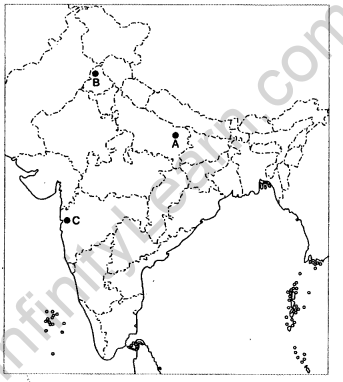
Answer:

Question 19.
On the given political outline map of India, locate and label the following with appropriate symbols. (All India 2016)
- The place where Gandhiji called off Non-cooperation movement.
- The imperial capital of Mughal.
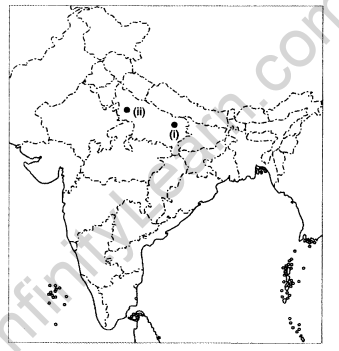
Answer:
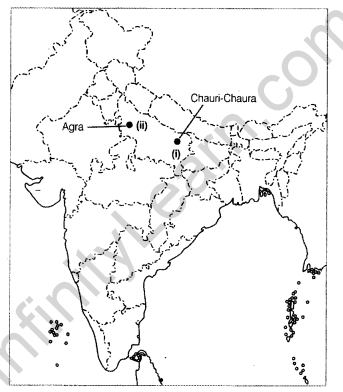
Question 20.
On the outline map of India three places related to the Indian National Movement have been marked as A, B and C. Identify them and write their correct names on thelines drawn near them. (Delhi 2015)
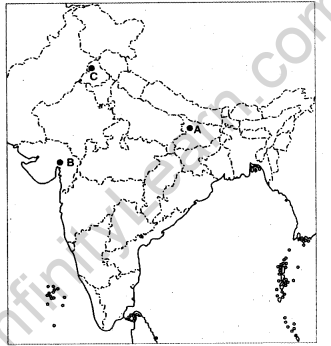
Answer:

Question 21.
On the map three centres of National Movement have been marked as 1, 2 and 3. Identify them and write their names 6n the line drawn near them. (All India 2010)
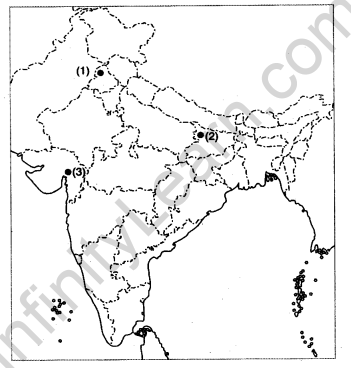
Answer:
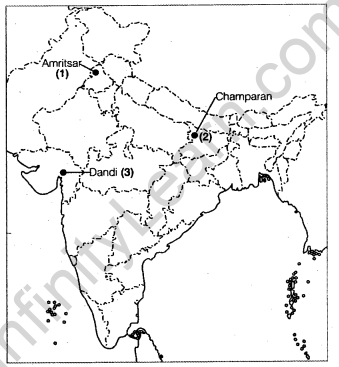
Question 22.
On the given political outline map of India locate and label the following. (All India 2009)
1. Dandi
2. Bardoli
Answer:
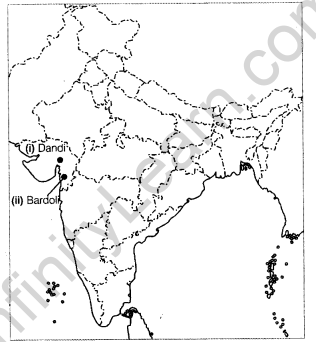
Question 23.
On the given political outline map of India, locate and label the following. (All India 2008)
1. Delhi
2. Goa
Answer:
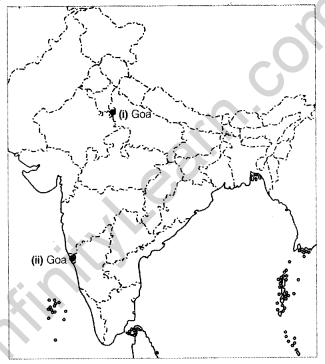
Important Questions for Class 12 History Chapter 12 Value Based Questions
Question 24.
Read the following passage and answer the question that follows.
Arya Samaj, a North Indian Hindu reform organisation of the late 19th and early 20th centuries particularly active in Punjab (tried to bring back Hindus who had converted to some other religion) Which sought to revive vedic learning and combine it with modern education in the sciences.
1. Illustate how the values integrated with the rich Indian literature paved way for the scientific development of modern India. (All India 2016)
Answer:
1. The two values were as follows:
- Rational and analytical values which are present in the ancient literature helps in developing scientific temperament in Indian people.
- The scientific and analytical values can revive vedic learning and combine it with modern education in the science.
Question 25.
Read the following passage and answer the question that follows.
Dr Khushdeva Singh describes his work as “humble efforts I made to discharge my duty as a human being to fellow human beings”.
1. “Love is stronger than hate”. How true is this value which was proved at the time of the partition of India? What are the values one needs to instill and nurture to avoid hatred? Explain.
(All India 2015)
Answer:
1. “Love is stronger than hate”. This value is proved by the act of Dr Khushdeva Singh and an act of lady in Jammu which saved the life of man. To avoid hatred and build feeling of love, there should be feeling of brotherhood, tolerance and empathy towards each other. There is a need to shed discriminations on the ground of trivial issues, and on the personal faith, belief, etc.
Question 26.
Read the following ‘value-based’ passage and answer the questions that follows.
The 77-year-old Gandhiji decided to stake his all in a bid to vindicate his lifelong principle of non-violence, and his conviction that people’s hearts could be changed. He moved from the villages of Noakhali in East Bengal (present-day Bangladesh) to the villages of Bihar and then to the riot-torn slums of Calcutta and Delhi, in a heroic effort to stop Hindus and Muslims kill each other, careful everywhere to reassure the minority community. In October 1946, Muslims in East Bengal targeted Hindus. Gandhiji visited the area, toured the villages on foot, and persuaded the local Muslims to guarantee the safety of Hindus. Similarly, in other places such as Delhi he tried to build a spirit of mutual trust and confidence between the two communities.
- Explain hoW the spirit of mutual trust and confidence building was initiated by Gandhiji.
- Explain the value mentioned in this passage. (All India 2013)
Answer:
1. Gandhiji toured these riot and violence . affected areas. He told crowd to assure the
safety of their fellow minority community. Trust and confidence between communities had completely broken due to riots and they started to see each other as enemy but when one community would take responsibility to protect and assure safety of other community then, again feeling of trust and confidence will start to develop among the communities.
2. In this passage value of non-violence, peaceful co-existence have been emphasised. Passage suggests that Gandhiji believed that people’s heart can be changed.
To foster the feeling of unity, to develop a mutual trust and confidence between the community, Gandhiji told communities to protect and assure the safety of minority community in that area. Gandhiji tried to impress upon the value of tolerance, respect for each other, and feeling of brotherhood between different religious communities.
Question 27.
- What is communalism? Explain.
- How can we weed out the virus of communalism from our society. (All India 2012)
Answer:
1. Communalism is a particular kind of politics based on the basis of religious identity. It is an ideology that seeks to promote conflict between religious communities. Communalism nurture a politics of hatred for people of other religion and believe that their interest are not common and sometimes even antogonist. During the partition period extreme level of communalism was there when people believed that peace-coexistence between Hindus and Muslims is not possible.
2. Communalism or communal politics can be countered by secularism or secular politics. People should adopt policy of tolerance and respect for other religions. Principle of peaceful co-existence should be followed by every community and sense of brotherhood should be spread.
Question 28.
- “Some scholars see partition as a culmination of communal politics.” Examine the statement.
- “Secularism is the best solution to the problems of communalism”. Comment. (Delhi 2011)
Answer:
1. The policy of direct action started by Muslim League led to loss of life and property. The fanatics of the Muslim League received further encouragement from the leaders of the Muslim League. A retaliation started in some of the Hindu provinces. Partition was considered better than the murder of the innocent people. Therefore, it may be called as the culmination of the communal politics. Scholars suggest that separate electorates for Muslims by government crucially shaped the nature of communal politics. Further, religious identities acquired a functional use within modern political system. Sadly communal identities came to mean active opposition and hostilities between communities.
2. Secularism is a principle that involves two basis propositions:
- The first is the strict separation of the state from religious institutions,
- The second is that people of different religious and beliefs are equal before the law. Secularism has a number of advantages.
These are:
- Separation of religion from state which is the foundation of secularism.
- It protects both believers and non-believers.
- It gives religious freedom to every single person.
- It is about democracy and fairness, where all citizens are equal before law.
- It provides equal access to public services.
- It provides free speech and expression.
Thus, we can say that secularism is the best solution to the problems of communalism.
Question 29.
- Why are the historians sceptical of oral history? Explain briefly.
- To what extent oral narratives, memoirs, diaries, family histories, first hand accounts help us to understand the trails and tribulations of ordinary people during partition of country? Explain with examples. (Delhi 2010)
Answer:
1. The historians are sceptical of oral history because:
- Oral data are not concrete and the chronology they yield may be imprecise.
- Historians argue that the uniqueness of personal experience makes generalisations difficult. A large picture cannot be built from such micro-evidence and one witness is not sufficient enough to paint the larger picture.
- Oral accounts are not directly related to the concerned issues.
- The small individual experiences, which remain in memory are irrelevant to the unfolding of larger processes of history.
2. Oral history presents the story of poor and powerless, it helps in exploring the experiences of men and women who were earlier ignored or taken for granted. Oral history enabled historians to write about pain and anguish of people during the time of partition.
Question 30.
“Amidst all turmoil following March 1947, Gandhiji valiant efforts bore fruit to bring harmony among the people”. Justify the statement. (All India 2011)
Answer:
The following efforts of Gandhiji bore fruit to bring harmony among the people at the time of partition:
- Gandhiji decided to stake everything to support his life long principle of non-violence and his conviction that people’s heart could be changed.
- He moved from the village of Naokhali in East Bengal to the villages of Bihar and then to the riot affected slums of Calcutta and Delhi in a heroic effort to stop communal fights between Hindus and Muslims.
- In October 1946, when Muslims in East Bengal targeted Hindus, Gandhiji visited the area, toured the villages on foot and convinced the Muslims to guarantee the safety of Hindus.
- In places like Delhi, he tried to build a spirit of mutual trust and confidence between Hindus and Muslims.
- On 28th November, 1947 when Gandhiji noticed that there were no Muslims on the Chandni Chowk road, he was very disappointed. He condenmed the mentality of those who wished to drive out every Muslim from the city, seeing them as Pakistani.
Question 31.
The India haters in Pakistan and Pakistan haters in India are the products of partition. Explain. (All India 2009)
Answer:
The India haters in Pakistan and Pakistan haters in India are the products of partition because of the following reasons:
- It has been mistakenly believed that the loyalties of Indian Muslim lie with Pakistan.
- Apart from this belief of pan-Islamic loyalties, other highly objectionable ideas come such as Muslims are cruel, bigoted, unclean, descendants of invaders. On the other hand, Hindus are believed to be kind, liberal, pure, children of the invaded.
- According to RM Murphy, similar stereotypes has proliferated in Pakistan. For instance, some Pakistanis believe that Muslims are fair, brave, monotheists and non-vegetarians while Hindus are dark, cowardly, polythesists and vegetarian.
- Some of these stereotypes predate partition but there is no doubt that they were immensely strengthened because of 1947.
- Every myth of these constructions has been systematically criticised by historians. However in both the countries voices of hatred are still persisting.

